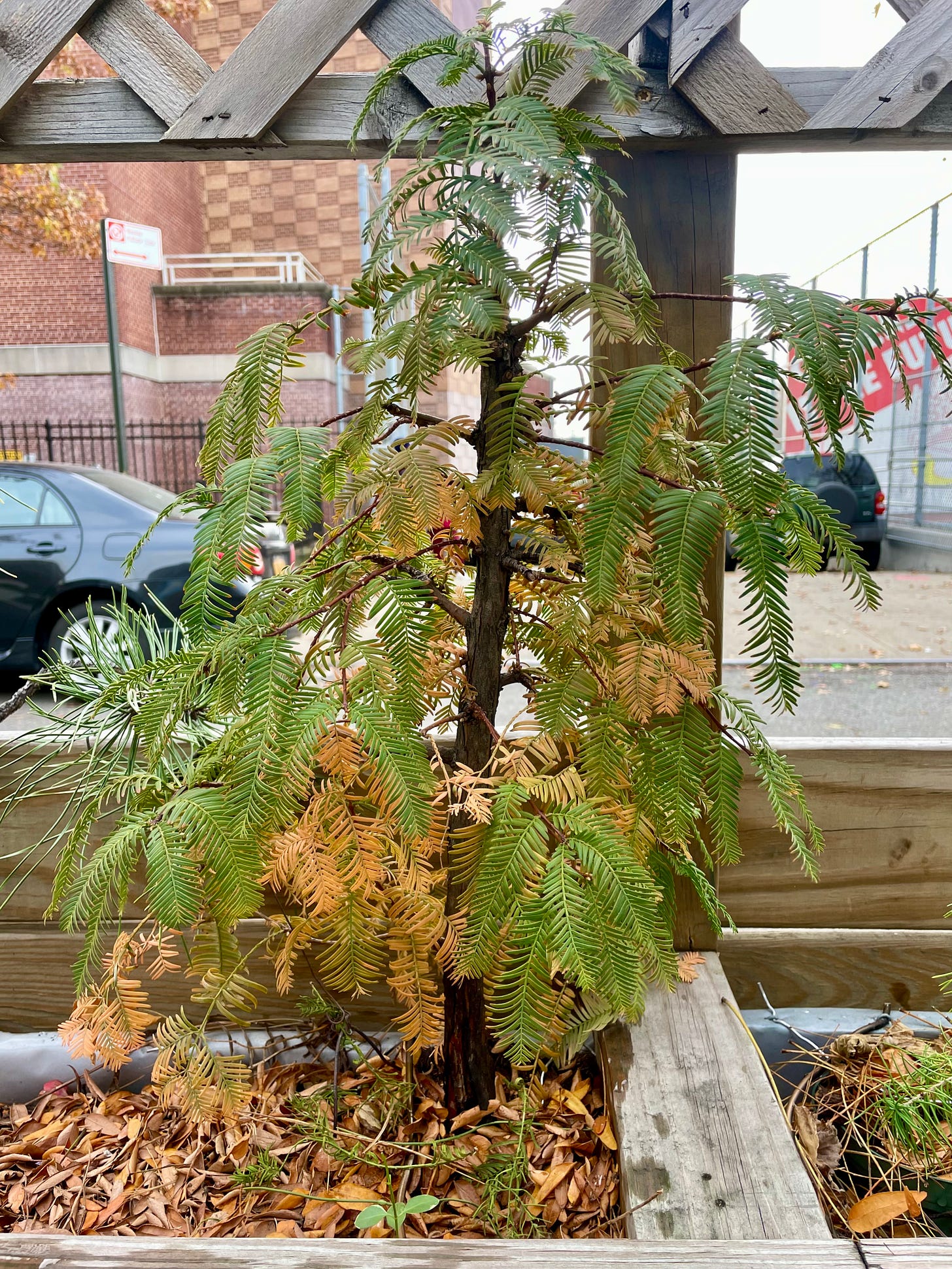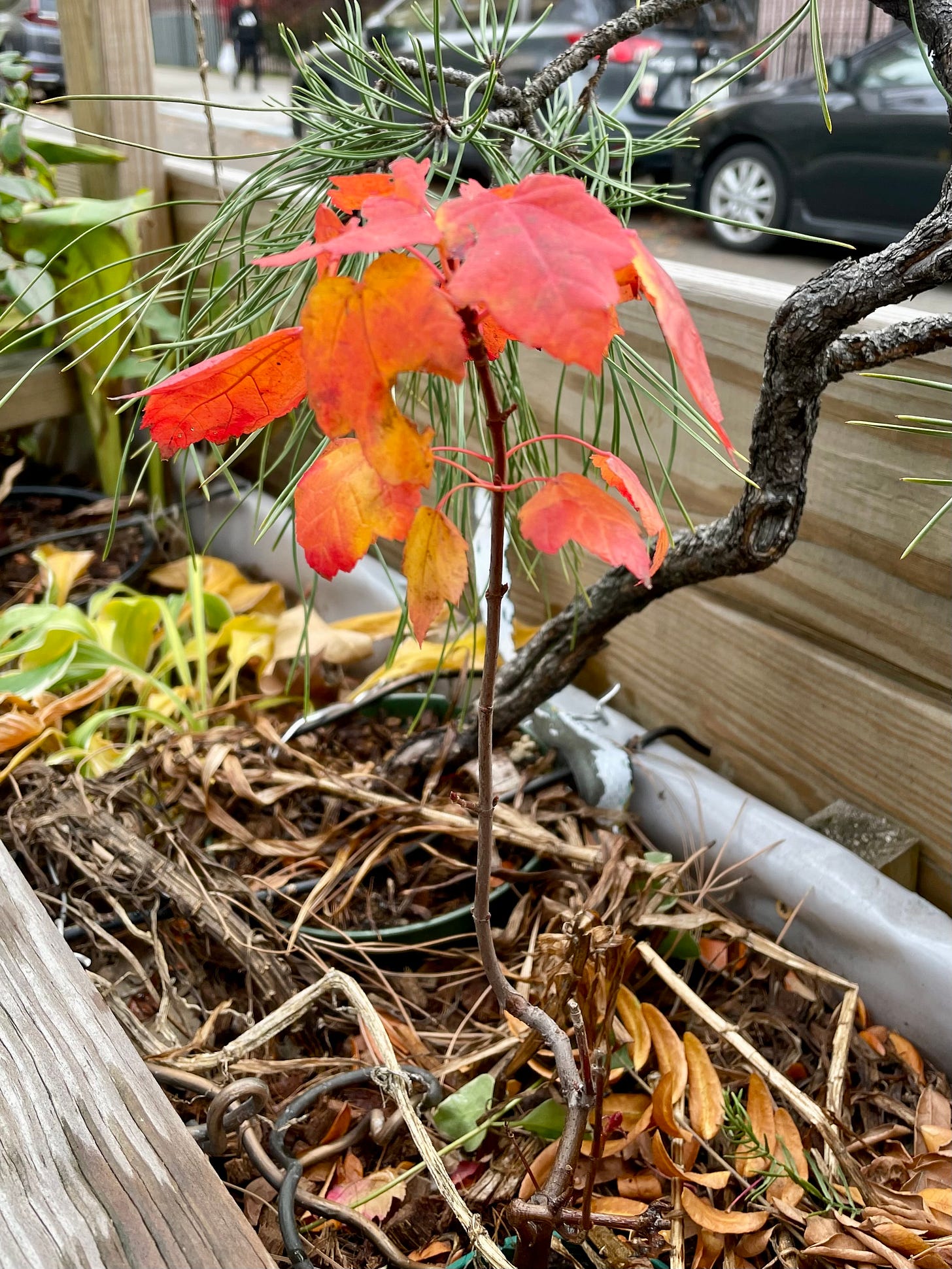As with many who grew up in the Northeast, the arrival of fall color feels integral to my biological rhythms. Birds migrate by magnetic fields; we mark time by the changing leaves. Since I started working with deciduous bonsai I’ve noticed a new anxiety that creeps up in October. Will my trees change color this year, or will something go wrong? They do, of course, though the change seem to come later each year. And each time it’s a relief and celebration. Another growing season finished, another ring of wood accumulated on the trunk. Fall colors are permission from nature to stop and catch my breath.
This is my red maple’s best fall color yet. The crimson hues extend to the leaves’ long petioles. They remind me of fireplace embers as they flick through the breeze.
My dawn redwood is still in transition. As green chlorophyl breaks down in the remaining active leaves, ruddy brown colors will peek through. I’m seeing the first hints of burgundy on my blueberry and strands of straw coloring on my larch. My anticipation grows by the day.
A refresher on plants and light. Plants appear green to us because they absorb light from the red and blue ends of the visible spectrum. Green lies in the middle of this spectrum, so the unused color is reflected back to us. Or more accurately, light rays with a wavelength of 500 to 560 nanometers are reflected back to us. That’s what color is: electromagnetic radiation of a certain wavelength. What we call the visible spectrum is a range of wavelengths that our eyes and brains can process. Dogs have a narrower range of visible colors; they hardly see green at all. Birds and insects can see ultraviolet colors that we don’t have names for.
What we think of as “seeing the world for what it is” has more in common with echolocation than any objective reality. Instead of outlining the world through reflected sound, we do it through reflected radiation. Our eyes focus that radiation onto photosensitive cells that convert light into data the way leaves convert it into food. Our brains rely on learned patterns and predictions to convert the data into a hallucination we can understand. This we call vision. We study the world through a prism and claim we know what goes on out there.
Fall colors offer us a view beyond the limits of our perception. The reflected yellows, reds, and oranges we see in autumn leaves were always there, just obscured by green chlorophyll. The tree stops feeding long enough to show us what we were missing.
There’s an H.P. Lovecraft story (and gnarly Nicolas Cage film) called The Color Out of Space, about a meteorite that crashes in a small town and emits a radioactive color beyond human understanding. Represented in the film as a screeching violet, the radiation begins to mutate the life around it. Crops grow abundant but taste inedible. Farm animals go mad, and people soon follow, their bodies breaking down and reinventing themselves in new, alien ways. The color acts like an invasive species. It suppresses the natural tendencies of the ecosystem around it and reshapes the environment to suit its needs. I find this surprisingly plausible for a Lovecraft story. Who knows what sources of radiation are out there, foreign to our planetary ecosystem and capable of hijacking our relationship to the life around us?
Psychologists consider smell to be a subjective sense that’s tied directly into human memory and emotion. Vision skews more objective, or at least easier to quantify. The human eye is pretty sophisticated compared to most animals. Sure, birds of prey can see like Superman, but most people comfortably regard our sense of vision as an apex of evolution.
Then I think about all the ways color penetrates my moods and memories. Fall colors engender in me feelings of awe, anxiety, delight, relief, security, and wonder. Even if I shut my eyes, the colors barge into my thoughts. I can’t say which of us sits at the wheel that steers the machine.
If I’m a hostage, I’m a willing one. Each year the fall colors make their mark. Working on trees of my own gives me an excuse to take some small amount of pride in their arrival, and all that they mean.
Tree reading
Ginkgo trees are unique in their habit of dropping all their leaves in a day or two. This makes them natural trackers of the real-world impact of warming climates. [NHPR]
Ultraviolet photos offer a peek at how pollinating birds and insects see flowers. [Lady Bird Johnson Wildflower Center]





